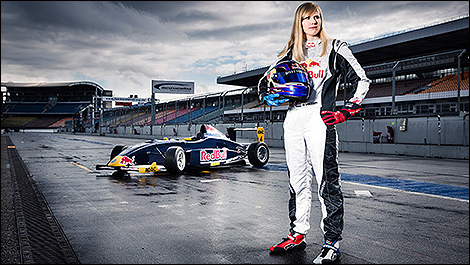Aug
2nd
Stay connected Subscribe to our RSS feed
There are female drivers in NASCAR and IndyCar, so why not in Formula 1? It's a question that's been asked for decades, yet remains unanswered.
Sure, a certain number of women have tried their luck over the years, including Maria Teresa de Filippis, Lella Lombardi, Davina Galica, Desiré Wilson, and Giavanna Amati. However, only the first two managed to deliver notable performances.
Climbing the echelons of auto racing all the way up to F1 requires one to bring world-class skills and lots of money to the table, not to mention excellent contacts and, yes, a bit of luck, too. It's the same thing for men and women.
Amati was hired by Brabham Racing in the early 1990s in a vain attempt to find new sponsors. The complete opposite happened with Danica Patrick. Immediately upon her arrival to IndyCar, she became an official spokeswoman for many companies such as GoDaddy.com.
In my opinion, the absence of women in F1 can't be explained by a lack of physical strength or endurance or any other similarly ridiculous reason. Rather, I believe that teams choose the most marketable female drivers instead of the best available drivers.
Before landing on the IndyCar scene, the young and attractive Patrick hadn't won a single car race (she did enjoy success in karting, however) -- not in Formula Vauxhall, not in Formula Ford, not in Barber Dodge Pro Series, not in Formula Atlantic.
Now, consider Susie Wolff, who recently did a few tests with a Williams F1: Aside from being one of the team's shareholder's wives she has accomplished very little in auto racing, other than a pair of 7th places in six DTM seasons.
I would rather see a woman with a more impressive résumé, like Simona de Silverstro or Katherine Legge, have an opportunity to try out for an F1 team. The former has actually won races in both Formula BMW and Formula Atlantic.
Watch out for Red Bull's latest rookie, Beitkse Visser. A fearsome karting driver, the Dutch phenom took the checkered flag in an ADAC Formula Masters race about two months ago. With plenty of determination and character, as well as the support of Red Bull, she could very well be the next female driver to compete in F1. All the blond-haired, 18-year-old has to do is keep winning, period.
Sure, a certain number of women have tried their luck over the years, including Maria Teresa de Filippis, Lella Lombardi, Davina Galica, Desiré Wilson, and Giavanna Amati. However, only the first two managed to deliver notable performances.
Climbing the echelons of auto racing all the way up to F1 requires one to bring world-class skills and lots of money to the table, not to mention excellent contacts and, yes, a bit of luck, too. It's the same thing for men and women.
Amati was hired by Brabham Racing in the early 1990s in a vain attempt to find new sponsors. The complete opposite happened with Danica Patrick. Immediately upon her arrival to IndyCar, she became an official spokeswoman for many companies such as GoDaddy.com.
In my opinion, the absence of women in F1 can't be explained by a lack of physical strength or endurance or any other similarly ridiculous reason. Rather, I believe that teams choose the most marketable female drivers instead of the best available drivers.
Before landing on the IndyCar scene, the young and attractive Patrick hadn't won a single car race (she did enjoy success in karting, however) -- not in Formula Vauxhall, not in Formula Ford, not in Barber Dodge Pro Series, not in Formula Atlantic.
Now, consider Susie Wolff, who recently did a few tests with a Williams F1: Aside from being one of the team's shareholder's wives she has accomplished very little in auto racing, other than a pair of 7th places in six DTM seasons.
I would rather see a woman with a more impressive résumé, like Simona de Silverstro or Katherine Legge, have an opportunity to try out for an F1 team. The former has actually won races in both Formula BMW and Formula Atlantic.
Watch out for Red Bull's latest rookie, Beitkse Visser. A fearsome karting driver, the Dutch phenom took the checkered flag in an ADAC Formula Masters race about two months ago. With plenty of determination and character, as well as the support of Red Bull, she could very well be the next female driver to compete in F1. All the blond-haired, 18-year-old has to do is keep winning, period.
 |
| Beitske Visser (Photo: Red Bull) |
 The latest auto news, reviews, prices, product and vehicle releases.
The latest auto news, reviews, prices, product and vehicle releases.